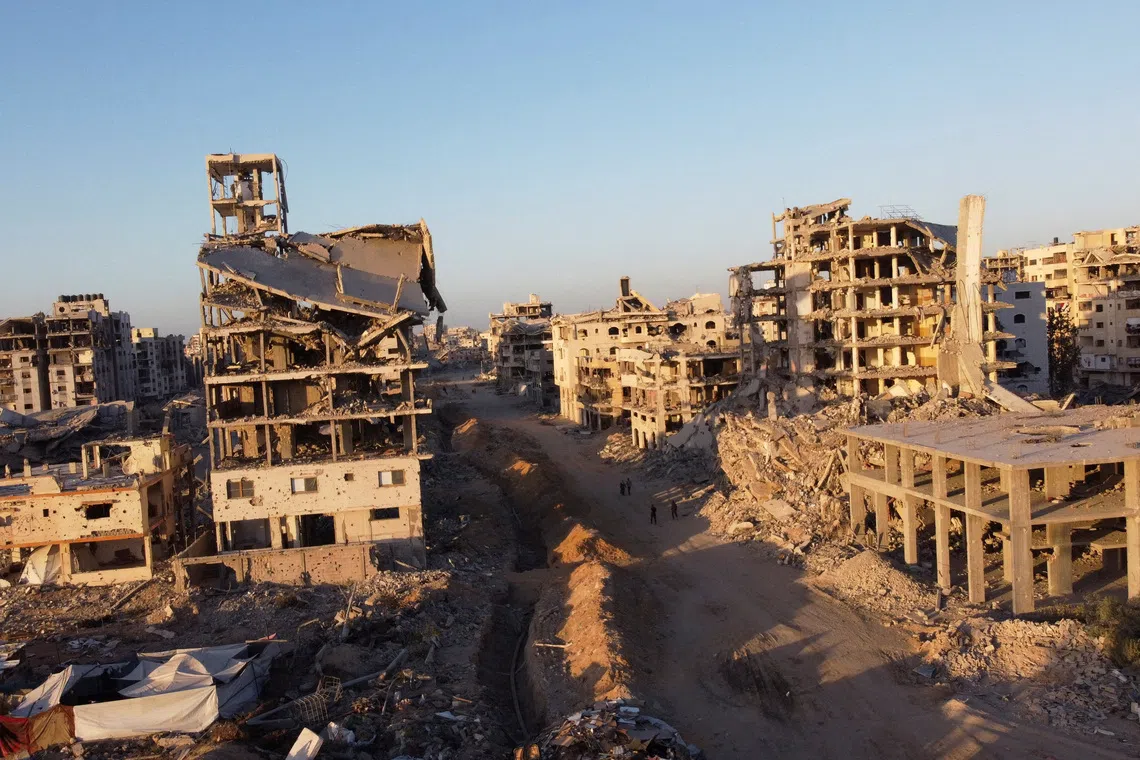Israeli strikes test Gaza’s fragile truce, Hamas to hand over two more dead hostages
Sign up now: Get ST's newsletters delivered to your inbox

The Israeli military said it carried out "precise" strikes against "terrorist infrastructure that posed a threat to the troops" in the areas.
PHOTO: REUTERS
Follow topic:
CAIRO – Israeli planes and tanks pounded areas in eastern Gaza on Oct 30, Palestinian residents and witnesses said, a day after Israel said it remained committed to a US-backed ceasefire despite launching more lethal bombardments in the territory.
Witnesses said Israeli planes carried out 10 air strikes in areas east of Khan Younis in the southern Gaza Strip, while tanks shelled areas east of Gaza City in the north. No injuries or deaths were reported.
The Israeli military said it carried out “precise” strikes against “terrorist infrastructure that posed a threat to the troops” in the areas, which Israel still occupies.
The Oct 30 strikes are the latest test of the fragile ceasefire that came into effect on Oct 10 in the conflict between Israel and Hamas.
“We’re scared that another war will break out because we don’t want a war. We’ve suffered two years of displacement. We don’t know where to go or where to come,” said a displaced man, Mr Fathi Al-Najjar, in Khan Younis.
At the tent encampment where Mr Najjar spoke, girls and boys were filling plastic bottles with water from metal containers placed on the side of the street, and women cooked food for their families using clay-made firewood ovens.
Return of deceased hostages
Under the ceasefire accord, Hamas released all living hostages in return for nearly 2,000 Palestinian prisoners and wartime detainees, while Israel pulled back its troops and agreed to halt its offensive.
Hamas also agreed to hand over the remains of all 28 dead hostages. It has returned 15 bodies, arguing that it will take time to locate and retrieve all of them.
The militant group’s armed wing announced on Oct 30 that it would hand over two more bodies of hostages at 4pm local time (10pm Singapore time).
The recovery and handover of bodies of hostages in Gaza has been one of the obstacles to US President Donald Trump’s Gaza plan, with Israel claiming that Hamas has been delaying the handover, an accusation Hamas denies.
Gaza officials say women and children killed
From Oct 28 to Oct 29, Israel retaliated for the death of an Israeli soldier with bombardments that the Gaza health authorities said killed 104 people.
Witnesses in Gaza said they did not see strikes on Oct 30 outside of the area Israel controls.
Israel says the soldier was killed in an attack by gunmen on territory within the so-called “yellow line” to which its troops withdrew under the ceasefire. Hamas has rejected the accusation.
The Israeli military issued a list of 26 militants it said it had targeted during the bombardment earlier this week, including one it said was a Hamas commander who participated in the Oct 7, 2023, assault
The Hamas-run Gaza government media office said Israel’s list was part of a “systematic campaign of misinformation” to cover up “crimes against civilians in Gaza”.
The Gaza Health Ministry said 46 children and 20 women were among the 104 people killed in the air strikes.
Sources close to international efforts to sustain the ceasefire said US and regional mediators swiftly intervened to restore calm as Israel and Hamas traded blame.
Strikes raise doubts in Gaza
People in the Gaza Strip, most of which has been reduced to wasteland, feared the tenuous truce would fall apart, saying that the last two days, in which they were deprived of sleep, felt like a revival of the two-year war.
“The situation is extremely difficult. The war is still ongoing, and we have no hope that it will end because of the conditions we are witnessing in the life we are living,” said Mr Mohammed Al-Sheikh.
The war has displaced most of Gaza’s more than two million people, some of them several times. Many have not yet returned to the areas they are from, fearing they could soon be displaced once again.
Gaza’s health authorities say that 68,000 people are confirmed to have been killed in the Israeli campaign and thousands more are missing.
Israel launched the war after Hamas-led fighters attacked southern Israel, killing 1,200 people and bringing 251 hostages back to Gaza, according to Israeli tallies. REUTERS

